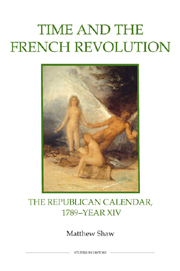Book contents
- Frontmatter
- Contents
- List of illustrations
- Preface
- Miscellaneous Frontmatter
- Acknowledgements
- Abbreviations
- Introduction: writing the history of the republican calendar
- 1 Time and history
- 2 The French republican calendar, 1793–1806: a narrative account
- 3 Cultivating the calendar: the calendar and republican culture in the Year II
- 4 The clash with religion
- 5 Work and rest
- 6 Republican hours
- Conclusion: the legacy of the republican calendar
- APPENDICES
- 1 Timeline of key events, 1788–1806
- 2 The republican calendar: a glossary
- 3 Names of the days of the republican year
- 4 Concordance for the Gregorian and republican calendars
- Bibliography
- Index
Introduction: writing the history of the republican calendar
Published online by Cambridge University Press: 12 September 2012
- Frontmatter
- Contents
- List of illustrations
- Preface
- Miscellaneous Frontmatter
- Acknowledgements
- Abbreviations
- Introduction: writing the history of the republican calendar
- 1 Time and history
- 2 The French republican calendar, 1793–1806: a narrative account
- 3 Cultivating the calendar: the calendar and republican culture in the Year II
- 4 The clash with religion
- 5 Work and rest
- 6 Republican hours
- Conclusion: the legacy of the republican calendar
- APPENDICES
- 1 Timeline of key events, 1788–1806
- 2 The republican calendar: a glossary
- 3 Names of the days of the republican year
- 4 Concordance for the Gregorian and republican calendars
- Bibliography
- Index
Summary
The upheavals of the French Revolution gave the world many things. Perhaps the most mellifluous of these are the series of Latin and Greek-based names – germinal, thermidor, and so forth – chosen by the dramatist and politician Philippe-François-Nazaire Fabre d'Églantine as the new months of the republican calendar. These neologisms, with their linguistic allusions to the seasons and the agricultural year, remain inseparably linked to the period, dating such events as the fall of Robespierre on 9 thermidor or Napoleon Bonaparte's coup of 18 brumaire. In this fashion, the Revolution left its impression on time. Such an imprint was intended: as the committee of public instruction's initial report to the National Convention argued in September 1793, the calendrier républicain offered the world a ‘new tool’ with which to inscribe the ‘annals of the French nation’, marking each anniversary of the founding of the republic as a new year. Together with reshaping the political world, the Revolutionaries endeavoured to define the republican age with a new system of days, months and years, commemorating the nation's achievements and laying the groundwork for a new future, free from the delusions of the past.
Since this inception, the republican calendar, which remained in use in France, its colonies and conquered territories from October 1793 until the end of 1805, has been understood in many ways: as the logical extension of the remapping of France's administrative geography and the reformation of weights and measures; as a statement of the Jacobins' utopian instincts and regenerative desires; as an instrument of dechristianisation; and as an analogue to the Terror, calculated, as Thomas Carlyle later noted, ‘for the Gospel of Jean-Jacques’.
- Type
- Chapter
- Information
- Time and the French RevolutionThe Republican Calendar, 1789-Year XIV, pp. 1 - 16Publisher: Boydell & BrewerPrint publication year: 2011



